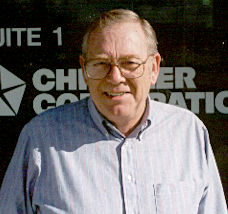February Executive Profile: Russ Ostler
Russ Ostler of Daimler-Chrysler Shows that the Benefit of Longevity is Perspective

It's a statistical fact that employees are spending less time at their companies now than ever before. It makes it a rare treat, then, to talk to someone like Daimler-Chrysler's Russ Ostler, who runs the company's training facility in Hacienda. He's spent 37 years with Chrysler, with more than 20 years providing technician training.
It's not the direction he intended to go at the beginning. "I was interested in electronics and it just so happened that life put me in the automobile business," he explains.
That interest began as a senior in high school, when he had the opportunity to attend the local vocational community college in Provo, Utah, where he grew up.
"I got quite intrigued with that because that was about the time that the transistor had been born," he says. "Most of the electronics still used vacuum tubes, so I got to study both transistor and vacuum tube technology. That was a fun period of time because you could start to see that industry grow."
A lack of demand in electronics led him to the automotive industry where, in the mid-60's, opportunities were plentiful.
"I actually started as a technician, and found that I didn't like engines and transmissions, so I figured out that I wanted to work more in the tune-up area: air conditioning, accessories, the electrical stuff."
Since those areas required the use of many remanufactured parts, Ostler's aptitude and experience made him a natural choice when Chrysler sought someone with field experience to oversee remanufacturing operations in Los Angeles in the early 70's.
It was then that he also introduced himself to training, by teaching a tune-up class at Riverside City College twice a week. It proved to be a fateful decision when, in '82, he moved into training for Chrysler.
"I enjoy teaching it's really quite a rewarding profession, and I've learned that there are many, many ways to do this job," he says.
For better or worse, he's been around to experience most of them as Chrysler has experimented over the last 20 years to determine the best means of training its technicians.
"There's been many different methods tried," he notes with an expression that shows that the whole story would take hours to tell. He explains that every combination was tried in efforts to put trainers, technicians, and teaching materials in the same place at the same time, sometimes with frustrating results.
"I could tell you some stories about mobile training that would stand your hair on end," he says.
Finally, their experience showed that the best way to go about it was to establish training centers and let the technicians come to them. Ostler was put in charge of the first of those built by an economically resurgent Chrysler, in San Francisco in 1985. Their Hacienda facility, which Ostler calls the best in the company next to Detroit's, opened in 1996, and serves over 1,300 technicians in the region.
There are still evolutionary changes in curricula but Ostler embraces those. Courses that incorporate CD-ROM training are the latest wrinkle, which suits a man who's still interested in electronics quite well.
He doesn't play as large a role in course design as he once did but he admires the other new technologies that have come along.
"We have a whole new computer-based diagnostic system," he says. "It multitasks, it gets information from Chrysler's mainframes, and it uses flash technology to update the vehicle's controllers."
Given Ostler's tastes, it's not surprising to find out that he also maintains the facility's two servers and the rest of their computer equipment. Even after 37 years around cars, it's still the electronics that he finds most interesting.
Also in this issue ...
- NetsWork is Making Connections
- eCoverage is On Call
- Business Bits
- Executive Profile — Russ Ostler, Daimler-Chrysler
- Jack Nadel, Inc., Shows that Marketing is Much More than Just Advertising
- Service Agencies and Service Clubs in the Tri-Valley
- SmartPool Makes it Easy for Would-Be Vanpoolers
- Looking for Fine Cuisine? Try a "Taste"
- One-Stop Career Center Hosts Local, State Services
- "Let Me Call You Sweetheart," Sings Quartet
- Hacienda Index




